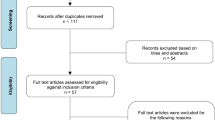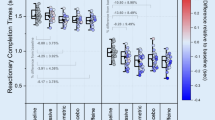Abstract
Purpose
The elite athlete is fine-tuned all around to deliver favorable results in sporting events. In this study, we address the question of whether basic movements—such as reflexes—and heterogeneous attentional modulation components—such as sensorimotor gating mechanisms—are also tuned up to maximize the results of middle-distance runners in physical conditioning tests.
Methods
We selected an array of professional middle-distance runners and healthy counterparts that were submitted to measurement of (1) physical conditioning parameters, including somatotype, jump, strength, and flexibility tests; and (2) sensorimotor gating mechanisms, including acoustic startle reflex, prepulse inhibition, and habituation.
Results
Our results showed athletes scored better on the athletic tests compared to controls, as expected. They also exhibited a lower startle amplitude, while maintaining higher prepulse inhibition values. They reacted faster to the acoustic stimuli, and sex-related differences—found in controls—were not present in athletes. Our data also pointed out to substantial correlations between sensorimotor gating and physical conditioning parameters.
Conclusions
All in all, these data may point to physical conditioning-driven neural plasticity of brain sensorimotor gating circuits in charge of triggering involuntary movements to harness control and efficiency over reflexed muscle activity.



Similar content being viewed by others
Abbreviations
- ASR:
-
Acoustic startle reflex
- BMI:
-
Body mass index
- CMJ:
-
Counter-movement jump
- DJ:
-
Drop jump
- EMG:
-
Electromyography
- PPI:
-
Prepulse inhibition
- SJ:
-
Squat jump
References
Bakker M, Van Dijk J, Van Den Maagdenberg A, Tijssen M (2006) Startle syndromes. Review Lancet Neurol 5(6):513–524
Bosco C, Komi P (1979) Potentiation of the mechanical behavior of the human skeletal muscle through prestretching. Acta Physiol Scand 106(4):467–472
Bosco C, Luhtanen P, Komi P (1983a) A simple method for measurement of mechanical power in jumping. Eur J Appl Physiol Occup Physiol 50(2):273–282
Bosco C, Mognoni P, Luhtanen P (1983b) Relationship between isokinetic performance and ballistic movement. Eur J Appl Physiol Occup Physiol 51(3):357–364
Braff DL, Geyer MA, Swerdlow NR (2001) Human studies of prepulse inhibition of startle: normal subjects, patient groups, and pharmacological studies. Psychopharmacology 156:234–258
Carter J (1982) Body composition of Montreal Olympic athletes. In: Carter J (ed) Physical structure of Olympic athletes part 1. The Montreal Olympic Games Anthropological Project. Karger, Basel, pp 107–116
Carter JEL, Health BH (1990) Somatotyping: development and applications. Cambridge University Press, Cambridge
Costa RM, Cohen D, Nicolelis MA (2004) Differential corticostriatal plasticity during fast and slow motor skill learning in mice. Curr Biol 13:1124–34
Davis M, Gendelman P (1977) Plasticity of the acoustic startle response in the acutely decerebrate rat. J Comp Physiol Psychol 91(3):549–563
Dawes TJ, Corden B, Cotter S, de Marvao A, Walsh R, Ware JS et al (2016) Moderate physical activity in healthy adults is associated with cardiac remodeling. Circ Cardiovasc Imaging 9(8):e004712. https://doi.org/10.1161/CIRCIMAGING.116.004712
Donnelly AA, MacIntyre TE, O’Sullivan N, Warrington G, Harrison AJ, Igou ER et al (2016) Environmental influences on elite sport athletes well being: from gold, silver, and bronze to blue green and gold. Front Psychol 7:1167. https://doi.org/10.3389/fpsyg.2016.01167. PMCID: PMC4972835
Geyer MA, Braff DL (1982) Habituation of the blink reflex in normal and schizophrenic patients. Psychophysiol 19(1):1–6
Granacher U, Gollhofer A, Strass D (2006) Training induced adaptations in characteristics of postural reflexes in elderly men. Gait Posture 24(4):459–466
Helms ER, Cronin J, Storey A, Zourdos MC (2016) Application of the Repetitions in Reserve-Based Rating of Perceived Exertion Scale for Resistance Training. Strength Cond J 38(4):42–49 (Epub 2016 Aug 3. PMID: 27531969; PubMed Central PMCID: PMC4961270)
Heyward VH (1977) Advanced fitness assessment and exercise prescription. Human Kinetics, Champaign
Jovanovic T, Szilagyi S, Chakravorty S, Fiallos AM, Lewison BJ, Parwani A et al (2004) Menstrual cycle phase effects on prepulse inhibition of acoustic startle. Psychophysiol 41(3):401–416
Judge LW, Burke JR (2015) Comparison of stretch reflex responses evoked during drop jumping in highly skilled athletes versus untrained subjects. J Sports Med Phys Fitness 2015 Jun;55(6):587–595
Kaltsatou A, Kouidi E, Fotiou D, Deligiannis P (2011) The use of pupillometry in the assessment of cardiac autonomic function in elite different type trained athletes. Eur J Appl Physiol 111(9):2079–2087
Kofler M, Muller J, Reggiani L, Valls-Solé J (2001) Influence of gender on auditory startle responses. Brain Res; 921:206–210
Ludewig K, Ludewig S, Seitz A, Obrist M, Geyer MA, Vollenweider FX (2003) The acoustic startle reflex and its modulation: effects of age and gender in humans. Biol Psychol 63:311–323
Luft AR, Macko RF, Forrester LW, Villagra F, Ivey F, Sorkin JD et al (2008) Treadmill exercise activates subcortical neural networks and improves walking after stroke: a randomized controlled trial. Stroke 12:3341–50
Marfell-Jones M, Olds T, Stewart A, Carter L (2006) International standards for anthropometric assessment. International Society for the Advancement of Kinanthropometry, ISAK, Potchefstroom, pp 32–89
Meincke U, Mörth D, Voss T, Gouzoulis-Mayfrank E (2002) Electromyographical differentiation between the acoustic blink and startle reflex. Implications for studies investigating startle behavior. Eur Arch Psychiatry Clin Neurosci 252(3):141–145
Mier CM (2011) Accuracy and feasibility of video analysis for assessing hamstring flexibility and validity of the sit-and-reach test. Res Q Exerc Sport 82(4):617–623 (PubMed PMID: 22276403)
Molina GE, Fontana KE, Porto LG, Junqueira LF Jr (2016) Post-exercise heart-rate recovery correlates to resting heart-rate variability in healthy men. Clin Auton Res 26(6):415–421 (PubMed PMID: 27510618)
Parasuraman R (1998) The attentive brain: issues and prospects. In: Parasuraman R (ed) The attentive brain. Mit Press, Cambridge (3 ± 15)
Powell SB, Weber M, Geyer MA (2012) Genetic models of sensorimotor gating: relevance to neuropsychiatric disorders. Curr Top Behav Neurosci 12:251–318
Rocha MSL (1975) Peso ósseo do brasileiro de ambos os sexos de 17 a 25 años. Arquivos de anatomía e antropología 1:445–451
Roche M, Commons KG, Peoples A, Valentino RJ (2003) Circuitry underlying regulation of the serotonergic system by swim stress. J Neurosci 3:970–7
Sheldon W (1950) The somatotype, the morphophenotype and the morphogenotype. Cold Spring Harb Symp Quant Biol 15:373–382
Swerdlow NR, Stephany NL, Talledo J, Light G, Braff DL, Baeyens D et al (2005) Prepulse inhibition of perceived stimulus intensity: paradigm assessment. Biol Psychology 69(2):133–147
Swerdlow NR, Sprock J, Light GA, Cadenhead K, Calkins ME, Dobie DJ et al (2007) Multi-site studies of acoustic startle and prepulse inhibition in humans: initial experience and methodological considerations based on studies by the Consortium on the Genetics of Schizophrenia. Schizophr Res 92(1–3):237–251
Taube W, Kullmann N, Leukel C, Kurz O, Amtage F, Gollhofer A (2007) Differential reflex adaptations following sensorimotor and strength training in young elite athletes. Int J Sports Med 28:999–1005
Valls-Solé J (2003) Startle and prepulse effects, chap 18. In: Hallett M (ed) Handbook of clinical neurophysiology, vol 1. Elsevier, pp 267–283. https://doi.org/10.1016/S1567-4231(09)70166-2 (ISSN 1567-4231, ISBN 9780444507259)
Valls-Solé J (2012) Assessment of excitability in brainstem circuits mediating the blink reflex and the startle reaction. Clin Neurophysiol (1):13–20
Würch A (1974) La femme et le sport. Med Sport Française 4:441–445
Acknowledgements
We would like to express gratitude to Laboratory 2 of the INCYL, especially Ana Alves and Peter Johannesen for helping with the calibration of the startle sound source; Juan Carro for assistance with bio-statistics; and Kristiina M. Hormigo for language editing services.
Funding
This study was partially funded by the Spanish Ministry of Science and Innovation, MICINN # BFU2010-17754. The funders did not take part in this study whatsoever.
Author information
Authors and Affiliations
Contributions
SH and CM conceived and designed research. SH and AC conducted experiments. CS contributed new reagents or analytical tools. SH, DEL, and CM analyzed data. SH wrote the manuscript. All authors read and approved the manuscript.
Corresponding authors
Ethics declarations
Conflict of interest
The authors declare no competing conflicts of interest, financial or otherwise.
Additional information
Communicated by Toshio Moritani.
Publisher’s Note
Springer Nature remains neutral with regard to jurisdictional claims in published maps and institutional affiliations.
Rights and permissions
About this article
Cite this article
Hormigo, S., Cardoso, A., Sancho, C. et al. Associations between sensorimotor gating mechanisms and athletic performance in a variety of physical conditioning tests. Eur J Appl Physiol 119, 921–932 (2019). https://doi.org/10.1007/s00421-019-04081-1
Received:
Accepted:
Published:
Issue Date:
DOI: https://doi.org/10.1007/s00421-019-04081-1




